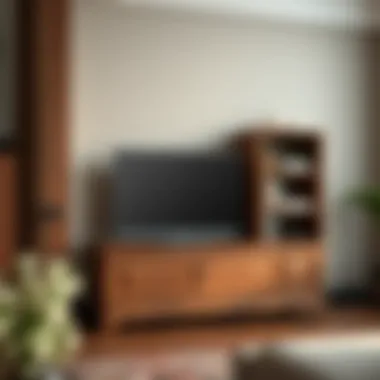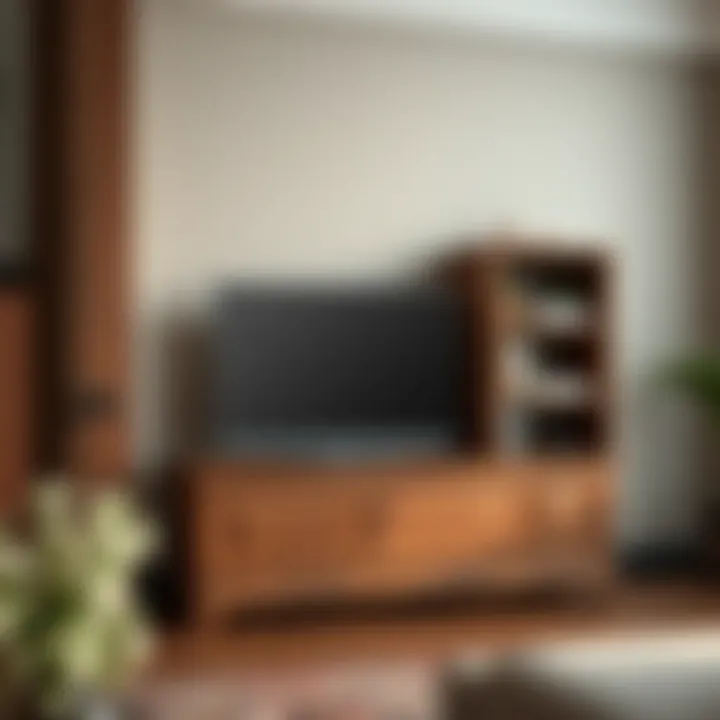Exploring 50 TV Cabinets: Functionality Meets Design


Intro
In today's modern living, a TV cabinet serves not just as a functional piece of furniture but as an extension of one’s personal style. It is the meeting point where technology converges with design, creating something both useful and visually appealing. The variety of options out there can confuse homeowners, interior designers, and furniture aficionados. This article sets sail into exploring 50 TV cabinets that mix functionality with aesthetics.
With technology driving the furniture industry, TV cabinets have evolved immensely over the past decade. They provide space for essential electronics, like streaming devices and gaming consoles, while also contributing to the room's decorative aspects. The goal is to dive into the dimensions of style and utility, providing insights into what makes a good TV cabinet stand out.
From classic wooden designs to sleek modern frames, each type of cabinet has its own characteristics. As we navigate through this assortment, we will spotlight materials, styles, and current trends that can help transform a bland living space into a sanctuary of comfort and functionality.
Understanding the right TV cabinet isn't just about making a choice; it's about making an informed decision that reflects both personality and needs. Stick around as we unpack the key points, trends, and tips you need to consider when diving into the world of TV cabinets.
Foreword to TV Cabinets
In the dynamic realm of home decor, the importance of a TV cabinet cannot be overstated. These pieces are not mere furniture; they serve as the backbone of your living room setup, striking a delicate balance between aesthetics and functionality. With the television being the central focus of many households, the way it is presented can significantly influence the overall feel of the space.
When diving into the world of TV cabinets, one quickly realizes that they come in a variety of styles, materials, and functionalities. This article aims to shed light on the nuances that differentiate one cabinet from another, giving readers the tools they need to make informed decisions. Furthermore, we will explore how these cabinets can enhance your living environment—transforming a utilitarian need into a statement piece.
What is a TV Cabinet?
A TV cabinet, also referred to sometimes as a media console or entertainment center, is designed to house electronic devices including televisions, DVD players, gaming consoles, and various media accessories. Typically, they come with shelving, drawers, and sometimes additional compartments to store CDs, DVDs, or even books. The case for a TV cabinet extends beyond merely holding a television; it provides a cohesive look, contributing to the room's stylistic narrative. The choice of design can range from sleek and modern pieces with clean lines to ornate, traditional units that evoke a sense of classic elegance.
One can think of a TV cabinet as a frame that elevates the visual presence of your entertainment system. They are designed not only to accommodate technology but also to blend harmoniously with the surrounding decor. Imagine plopping down to watch your favorite series on Netflix, the cabinet holding everything right there, creating an organized atmosphere that promotes relaxation.
Importance of TV Cabinets in Home écor
TV cabinets play a significant role in home décor for various reasons:
- Aesthetic Appeal: First and foremost, a well-chosen TV cabinet can tie a room together. It can complement existing furniture or introduce a splash of color and texture that enhances the overall aesthetic.
- Organization: With built-in storage options, these cabinets help manage clutter by providing designated spaces for your electronics and media. A messy living room can be a real eyesore, and having an organized cabinet can ease visual chaos.
- Functional Design: The availability of various features—like cable management systems, adjustable shelves, and multiple compartments—add to their functionality, making them practical pieces in any home.
- Cultural Significance: Different styles of TV cabinets mirror cultural trends and personal tastes. Whether someone prefers the sleek lines of minimalism or the rustic charm of reclaimed wood, a cabinet can reflect individual identity.
Understanding Different Styles of TV Cabinets
When it comes to the world of TV cabinets, style isn’t just about aesthetics; it's a reflection of personal taste and practical needs. The array of styles available can dramatically influence both the functionality and visual appeal of your living space. Understanding these different styles enables homeowners and designers to choose cabinets that not only fit the technological demands of current media setups but also harmonize with the overall decor of the room. Whether you’re looking for sleek modernism or rustic charm, each style contributes uniquely to the ambiance of your home.
Modern Minimalist TV Cabinets
Modern minimalist TV cabinets embody simplicity and elegance. Often characterized by their clean lines and lack of unnecessary ornamentation, these cabinets are designed to create a seamless look that enhances rather than overwhelms. Commonly constructed from materials like MDF or plywood, they tend to be functional yet chic. The focus here is on maximizing space and functionality without the clutter of excessive design.
Benefits of Modern Minimalist TV Cabinets:
- Sleek Aesthetic: Their unobtrusive nature makes them perfect for contemporary homes that value minimalism.
- Versatile Color Options: They often come in neutral colors, allowing them to blend easily with various design elements.
- Space Efficiency: These cabinets usually come with built-in storage solutions that keep the area tidy without compromising style.
Traditional Wooden TV Cabinets
If you're after warmth and a classic feel, traditional wooden TV cabinets might just be your cup of tea. These cabinets can range from intricate designs with carvings and moldings to simple, robust structures made from solid hardwood. They often evoke a sense of nostalgia, providing character and depth to a room.
Considerations for Traditional Wooden TV Cabinets:
- Durability: Solid wood is known for its longevity, being able to withstand the test of time.
- Natural Aesthetics: These cabinets bring a touch of nature indoors, offering unique grain patterns and colors.
- Design Flexibility: They can easily fit into various interior styles, from vintage to rustic, making them a wise long-term investment.
Industrial-Style TV Cabinets
For those who prefer a more rugged and urban vibe, industrial-style TV cabinets are the way to go. Typically made from a combination of metal and wood, these cabinets can add a robust and edgy touch to a living space. Their raw finishes and distressed look create a bold statement.
Benefits of Industrial-Style TV Cabinets:
- Unique Appearance: The combination of materials often results in one-of-a-kind pieces full of character.
- Sturdy Construction: Heavy-duty metal frames ensure reliability and durability in supporting your entertainment setup.
- Easily Maintained: The materials used are not only tough but usually require less special treatment than more delicate furnishings.
Wall-Mounted TV Cabinets
If you’re short on floor space or want to create a visually lighter environment, wall-mounted TV cabinets might be the best choice. These cabinets are designed to provide a sleek, floating appearance, allowing homeowners to display their TVs without taking up valuable ground space.
Considerations for Wall-Mounted TV Cabinets:
- Space-Saving Solution: Ideal for smaller rooms, they maximize floor area and visually open up the room.
- Clean Installation: Cables can often be hidden behind the wall, resulting in a tidy and uncluttered look.
- Design Versatility: Available in various styles, they can easily complement any design motif from contemporary to eclectic.
Choosing the Right Material for Your TV Cabinet
Selecting the right material for your TV cabinet is crucial. This choice influences not only the unit’s appearance but also its durability, functionality, and how well it blends into your living space. With various materials to choose from, understanding the pros and cons of each can help you make an informed decision tailored to your needs and aesthetics.
Wood: A Timeless Choice
Wood has a certain charm that makes it a perennial favorite among homeowners. It's not just about looks; wooden cabinets can complement a range of interior design styles, from rustic to contemporary. The aesthetic warmth of wood enhances a room's comfort and coziness
Advantages of wood include its natural strength and resistance to wear. Furniture crafted from hardwood, such as oak or maple, can last for decades, often becoming cherished family heirlooms. Wood cabinets can also be stained or painted to match any decor, making them highly versatile.
However, potential downsides do exist. Wood can warping or cracking with fluctuations in humidity levels over time. Not all wood is created equal, and cheaper particle board often lacks the robustness of solid wood. Thus, measuring quality is essential—opt for furniture made from solid wood or high-quality plywood for better durability.


Metal: Durability and Style
Metal TV cabinets are gaining traction for their modern appeal and durability. When you think of a metal cabinet, you might picture a sleek, industrial look that blends effortlessly with contemporary design. These cabinets are typically constructed from steel or aluminum, offering a robust alternative to traditional materials.
One key benefit is their resistance to temperature and moisture, making them ideal for various environments. You can place a metal cabinet in a damp basement or a sunny living room without worrying about warping or decay as one might with wood. Moreover, they often feature an edginess that resonates with minimalist and urban aesthetics.
Yet, they aren’t without challenges. Metal can be cold to the touch and potentially less inviting than warmer materials. Also, fingerprints might show more easily, requiring regular maintenance to keep them looking pristine. Thus, consider your space and how you intend to use the cabinet before diving into this stylish choice.
Glass: Elegance and Light
When it comes to adding a touch of elegance, glass cabinets often steal the spotlight. They can make a room appear more spacious and airy, as the transparency tends to blur lines and create an illusion of openness. Glass shelves can showcase decorative items, adding a personal touch to your decor.
This material is often used in combination with wood or metal to create a striking visual contrast. However, this can also serve as a drawback. Glass requires regular cleaning to remain smudge-free, and its vulnerability means you must handle it with care. It’s not just about beauty; durability is something to maintain in mind. Investing in tempered glass can mitigate some risks, as it is designed to withstand impact better than standard glass.
MDF vs. Plywood: Understanding the Differences
When it comes to engineered wood products, Medium Density Fiberboard (MDF) and plywood are two popular choices. Understanding their differences can save time and effort when selecting your cabinet.
- MDF is made from wood fibers glued under heat and pressure. It's smooth, which makes it excellent for painting and finishing. This is ideal if you want a sleek, uniform surface. However, it doesn’t hold up well in moist environments.
- Plywood, on the other hand, consists of multiple layers of wood veneer glued together. This gives it greater strength and moisture resistance compared to MDF. It has a more natural wood finish and is less likely to warp. For those looking for durability with aesthetic appeal, plywood can be more advantageous.
Each material has its own place in constructing a TV cabinet. Your final decision should consider not only functionality but how the material will align with your entire living space's design.
"Choosing the right material for your TV cabinet is like picking the right outfit for an important occasion; it’s about making a statement while still being functional."
In summary, the material you choose for your TV cabinet can significantly impact durability, style, and usability. Whether you opt for the timelessness of wood, the strength of metal, or the elegance of glass, each choice holds potential advantages and limitations.
Functional Considerations in Selecting a TV Cabinet
When it comes to choosing a TV cabinet, it’s not merely about aesthetics. While a sleek design can certainly catch the eye, the functionality of the cabinet often makes or breaks the overall experience. The TV cabinet serves as a central piece in your living room, influencing how everything else looks and operates. By considering functional elements, homeowners can ensure they’re making a wise investment that serves their needs over the long haul.
Storage Solutions: Shelves and Drawers
A well-thought-out storage solution is essential. Most modern TVs come with a slew of gadgets, from gaming consoles to streaming boxes, needing a designated spot. Shelves and drawers provide flexibility in organization, letting you arrange everything in a way that suits your style and functionality.
- Open shelves allow easy access to gaming consoles, DVDs, and books, encouraging you to keep your living space tidy. They can also display decorative items, bridging function and design.
- Drawers are great for hiding away the clutter that can easily accumulate, such as remote controls, video games, or miscellaneous items you don't want on display.
A handy tip is to look for cabinets with adjustable shelves, giving you the ability to create customizable spaces. Some homeowners even opt for pull-out drawers, which can be useful for easy access. When choosing storage options, think about what you need to store and how often you'll need to access those items.
Cable Management Systems
Let’s face it: cables can be the bane of a stylish living room. An effective cable management system ensures that your TV cabinet won’t turn into a tangled mess resembling a bird’s nest.
Many cabinets come designed with features like:
- Cable holes at the back to keep cords organized and out of sight
- Built-in cable trays to route excess wire neatly
- Hidden compartments where you can tuck cables away without losing access
Homeowners should prioritize cabinets with effective cable management. Not only does it keep your space looking sharp, but it also can prolong the life of your electronics by minimizing wear and tear. Investing in a cabinet that emphasizes good cable management will save you a headache down the road.
Weight Capacity: Important Considerations
One of the most critical aspects to consider when selecting a TV cabinet is the weight capacity. Not all cabinets are created equal; some are designed to support larger, heavier televisions, while others might buckle under pressure. Here are a few things to keep in mind:
- Check the manufacturer's specifications for weight limits to avoid unfortunate mishaps.
- Consider your TV size and type. Flat-screen TVs are typically lighter than their older counterparts but they still require sturdy support.
- Additional equipment like gaming consoles, cable boxes, and sound systems can add considerable weight, so factor these in when calculating weight.
When in doubt, bigger is often better. Choose a cabinet that exceeds the combined weight of your equipment to ensure stability and safety.
Knowing these foundational aspects empowers homeowners to select a TV cabinet that's not just visually appealing but also practical and robust. This ensures your TV cabinet not only fits your decor but also enhances your daily entertainment experience.
Size and Dimensions: Finding the Perfect Fit
Choosing the right size and dimensions for your TV cabinet is more than just a matter of aesthetics. It serves as a foundational aspect in ensuring that your furniture not only looks good but also complements your living space effectively. A cabinet that suits your TV size, room layout, and intended use can dramatically enhance both functionality and visual appeal. Think about it: an oversized cabinet in a compact room can make the space feel cramped, whereas a tiny unit in a vast living area may get lost in the shuffle.
When you’re considering a new TV cabinet, the dimensions should align with multiple aspects of your room. This includes the existing furniture, the height of the seating arrangements, and the overall flow of movement within the space. A little attention to these details can go a long way in getting a sense of balance in your decor.
Measuring Your Space Appropriately
Before you dive into hunting for that ideal cabinet, grab a tape measure and take some crucial measurements of your space. Start by measuring the area where you plan to place the TV cabinet. Here are some key tips to ensure you measure accurately:
- Height: Measure from the floor to the point where the TV will sit. Ideally, the center of the screen should be aligned with the viewer's eyeline from a seated position, often around 42 inches from the ground.
- Width: Make sure to account for the overall space available; this includes any additional space needed for cable management or decorative items that might find a home on or around the cabinet.
- Depth: Don’t overlook depth! Measure how far you can afford for the unit to extend from the wall. Be mindful of doors and traffic paths.
Using these dimensions, you can effectively narrow down cabinet options that will fit seamlessly into your design without creating clutter.
Proportions: Balancing Height and Width
Proportions play a vital role in how well a TV cabinet integrates with the rest of your room. Getting the right balance between height and width can't be overstated. Consider these aspects when assessing proportions:


- Visual Weight: A large TV on a flimsy-looking cabinet can create visual dissonance. Choose a piece that offers a sturdy appearance without being overwhelmingly bulky.
- Design Continuity: The cabinet should reflect the scale of other furniture pieces. For example, an oversized sectional might call for a larger TV cabinet to maintain visual harmony, while a delicate, minimalistic sofa might benefit from a lighter, streamlined cabinet.
- Functional Areas: Think about the activities in your room. If you plan to use the cabinet for storage or display, ensure there’s enough surface area and shelving without overshadowing the space.
In summary, understanding the interplay of size and proportions ensures that your chosen TV cabinet complements both the furniture and the room as a whole. Taking the time to measure and assess can spare you from the heartache of returning an ill-fitted piece or, worse, living with a design blunder for years to come.
"A TV cabinet is not just a piece of furniture; it's a pivotal element that shapes how you experience your living area. Measure twice, choose wisely."
For additional tips on home decor and design, consider checking resources like Wikipedia or Britannica.
By fully grasping the importance of fit, you lay the groundwork for a television area that truly resonates with your personal style and needs.
Design Trends in TV Cabinets
The landscape of TV cabinets has evolved significantly in recent years, mirroring broader shifts in interior design and technology. With increasing choices available, design trends are pivotal in guiding homeowners, designers, and DIY enthusiasts toward smarter selections that do more than just house a television. Well-selected cabinetry isn't merely about aesthetics; it encompasses functionality and forms an essential part of the living experience. As living spaces shrink in urban areas, it's necessary to optimize every square inch without sacrificing style.
Trends reveal a shift towards cabinets that marry adequate storage capabilities with sleek designs. There's a prevalent move from traditional solid structures to more modern, elegant designs which echo a minimalist approach, allowing for open spaces while still providing utility. Homeowners are paying more attention to how their furniture integrates with their lifestyle rather than just filling a void in a room.
Sustainable and Eco-Friendly Materials
In a world increasingly concerned with environmental impact, the use of sustainable and eco-friendly materials in TV cabinets has become a focal point. Shoppers today often prefer products that not only look good but also contribute positively to the environment. Options like bamboo, reclaimed wood, and recycled materials have gained traction.
- Bamboo: Known for its rapid growth and minimal resource requirements, bamboo is a strong choice. It offers durability while being lightweight and versatile in its aesthetics.
- Reclaimed Wood: Utilizing material from old barns or homes not only provides character but also helps to reduce waste. Each piece has a history, which brings a unique charm to the furniture.
- Recycled Materials: These can include metal, glass, or even plastics, allowing for modern designs that speak to chic sensibilities while supporting sustainability efforts.
The aesthetic beauty of eco-friendly options is bolstered by their story, turning furniture procurement into an intentional act, resonating with the conscious consumer.
Smart Technology Integration
Smart technology is no longer a luxury; it’s becoming a necessity in contemporary living environments. The integration of smart features in TV cabinets is revolutionizing the way people interact with their home entertainment systems. From hidden storage compartments for devices to cabinets that can control your home automation systems, the future is wide open.
Some key elements include:
- Integrated Charging Stations: These conveniently allow media devices and gaming controllers to charge without cluttering the surface.
- Bluetooth Speakers and Built-in Amplifiers: These features mean you can enjoy superior sound quality without needing separate equipment.
- Cable Management Solutions: Smart cabinets come with built-in mechanisms to keep cables organized and out of sight, creating a cleaner look.
Smart cabinets address modern complications of home entertainment with elegant solutions. Not only do they facilitate seamless engagement with technology, but they also reflect a commitment to innovation within a stylish framework.
"In the realm of design, it's the marriage of functionality and sophisticated aesthetics that creates a truly compelling living space."
With these trends, consumers can see the potential for television cabinets that not only meet their viewing needs but also complement their homes and lifestyles. As design becomes more intentional, each choice can speak volumes about one's values and preferences.
Maintenance and Care for TV Cabinets
Taking care of your TV cabinet can mean the difference between a striking centerpiece and a fading memory in your living room. Maintenance and care are not just about extending the lifespan of your furniture; they also play a vital role in preserving its aesthetics and functionality. When you invest in a TV cabinet, its upkeep becomes a priority as it dramatically affects the overall vibe of the space where it's placed.
Benefits of Proper Maintenance:
- Longevity: Regular cleaning and care can minimize wear and tear, allowing your cabinet to last longer.
- Aesthetic Appeal: A well-maintained cabinet retains its original beauty. Dust, grime, and scratches can make any piece appear neglected.
- Functionality: Over time, dirt and debris can affect drawers, shelves, and moving parts. Maintenance ensures smooth operation and accessibility.
Remember, a clean cabinet creates a welcoming ambiance while also reflecting the care you invest in your home.
Cleaning Techniques for Various Materials
Different materials require specific cleaning methods to maintain their integrity and luster. Here’s how to tackle the maintenance of some popular TV cabinet materials:
Wood:
- Dusting: Regularly use a microfiber cloth to dust surfaces to avoid buildup.
- Cleaning: For deeper cleaning, a solution of vinegar and water works wonders. Just ensure to avoid soaking the wood.
- Polishing: Use furniture polish occasionally to keep it gleaming.
Metal:
- Wipe Down: A damp cloth with mild soapy water usually does the trick.
- Rust Prevention: For any exposed parts, a touch of oil can prevent rust.
- Protection: Consider applying a metal sealant to enhance durability against scratches.
Glass:
- Streak-Free Shine: Use a glass cleaner or a simple mix of water and vinegar to prevent streaks.
- Delicate Handling: Always use a soft cloth to avoid scratches on the surface.
MDF and Plywood:
- Dusting and Wiping: A damp cloth with mild soap is best to keep the finish intact.
- Avoid Excess Water: MDF can swell if exposed to too much moisture, so be cautious.
By integrating these techniques, your TV cabinet can remain a shining star in your living room.
Protective Measures and Coatings
Protective measures are essential in ensuring that not only does your cabinet look good, but it also withstands daily wear and tear. Here are some practical applications to consider:
Varnish and Sealants:


- For wooden cabinets, applying a high-quality varnish can act as a barrier against moisture and dirt. Choose a finish suitable for your specific type of wood for best results.
Soft Cushions:
- Place soft pads or coasters where items meet the surface, like speakers or decor. This prevents scratches and adds a layer of gentle support.
UV Protectant:
- For glass surfaces or any materials exposed to sunlight, a UV protectant can minimize fading and yellowing, preserving the original color over time.
Regular Inspections:
- Make it a habit to check for loose screws or fittings. Tighten them up to avoid any wobbling.
Budgeting for Your TV Cabinet
When it comes to furnishing your living room, a TV cabinet is more than just a place to park your television. It significantly impacts the overall aesthetics and utility of your space. Thus, budgeting for a TV cabinet is paramount. Proper financial planning ensures that you don’t overspend on a piece that may not suit your needs or match your décor. Setting a budget allows you to focus your search on cabinets that not only meet your stylistic preferences but also align with your financial capabilities. This balancing act between function and finance is essential for making an informed decision.
Understanding Price Points
The price of TV cabinets can vary widely, influenced by factors such as size, material, and design complexities. It's essential to comprehend these price points so you can set an accurate budget.
- Material Selection: Solid wood cabinets usually come with a higher price tag compared to MDF or particle board options. Quality materials enhance longevity but can stretch your budget.
- Size and Dimensions: Larger cabinets tend to cost more. Also, wall-mounted designs might require additional expenses for installation.
- Design Features: Features like built-in cable management systems, additional shelving, and custom layouts can elevate the price. Take note, a cabinet that caters to your needs might justify a higher investment.
In setting your budget limit, consider these elements closely. You might be surprised to find that a quality cabinet does not need to break the bank, provided you know exactly what you want and need.
Investing in Quality vs. Cost-Effective Options
Deciding between investing in a high-quality TV cabinet versus settling for a cost-effective option can be a tricky navigation.
- Durability versus Short-Term Savings: Higher-priced options generally mean better materials and craftsmanship. A well-made cabinet can hold up for years, whereas cheaper variants might fall apart sooner. In short, sometimes more initial cost saves you money in the long run.
- Aesthetics: A high-quality cabinet can serve as a centerpiece in your room. On the other hand, a lower-cost option might serve its primary function but may leave your living space looking less than appealing.
- Resale Value: A quality piece can add value to your home and could be sold later at a good price, whereas cheaper options usually depreciate quickly.
Important Consideration: Weighing immediate costs against long-term benefits can result in a purchase that you won't come to regret.
Aesthetics vs. Practicality: Striking a Balance
In the world of interior design, finding that sweet spot between aesthetics and practicality is akin to walking a tightrope. When it comes to selecting TV cabinets, this balance becomes paramount. Homeowners and designers alike need to grapple with what looks good and what truly functions well. So, why does this matter? Well, a TV cabinet isn’t just a place to store your television or media devices; it can shape the overall ambiance of your living space while providing essential functions.
This duality of purpose can be a bit of a head-scratcher. On one hand, you want a unit that feels visually cohesive with the rest of your décor. On the other, you need something that accommodates storage needs, cable management, and weight capacity. A cabinet that excels in practicality may appear more like a utilitarian box, while a stunning piece of art may offer no actual benefits. To navigate this challenge, consider the following aspects:
- Functionality must lead the way. If a design feature hinders function, it needs reevaluation. A beautiful piece of furniture that can't hold the weight of your TV or hide cords effectively won't win any favor with users.
- Versatile design. Look for cabinets that offer both style and storage. Sliding doors, for example, can provide a sleek aesthetic while making it easy to access remote controls or extra cables.
- Material matters. The choice of material plays a significant role. A solid wood cabinet melds sturdiness with beauty, while glass accents can create an airy feel but may not hide clutter as effectively.
"A well-designed cabinet serves as both a functional device and a piece of artwork, complementing your living space while being practical enough to handle daily use."
How Design Choices Affect Functionality
Every design choice can throw a wrench into practicality if not chosen carefully. Think about the arrangement of shelves and drawers. A cabinet with adjustable shelving allows users to customize storage space for different devices or decorative items. If you’re trying to fit a gaming console next to a DVD player, fixed shelves might make your life a whole lot tougher.
Furthermore, the layout can also impact cable management, which, let’s be honest, can become a tangled nightmare without a proper system in place. Whether it’s hidden openings for wires or even a designated cable box, thoughtful design will keep your space looking sharp and clutter-free.
The finish on the cabinet's surface contributes to usability as well. A glossy finish may be appealing but prone to fingerprints, whereas a matte option might resist smudges yet show dust quicker. Each choice cascades down to how effectively your cabinet serves its dual role.
Custom vs. Pre-Fabricated Models
When diving into the realm of TV cabinets, a key decision often comes down to choosing custom models versus pre-fabricated options. Custom cabinetry has its own charm, namely tailored dimensions, colors, and materials. Homeowners can collaborate with craftsmen to design a unit that meets exact needs and fits perfectly in odd spaces—like that nook in the corner that no one knows how to decorate.
However, availability and cost come into play. Custom options generally come with a heftier price tag. They also necessitate several weeks, if not months, of wait time. On the flip side, pre-fabricated models boast immediate availability and a range of styles—from the austere to the flamboyant. They typically are easier on the wallet, making them an appealing choice for budget-conscious consumers.
Ultimately, the decision boils down to individual needs. If you're looking for something specific that meshes with your room like a puzzle piece, custom could be the way to go. If you're after a quick fix that won’t break the bank, ready-made cabinets have you covered.
Finale: Making an Informed Choice
When it comes to selecting a TV cabinet, the culmination of various factors influences the final decision. This article emphasizes the synergy between functionality and aesthetics in TV cabinets. A well-chosen TV cabinet serves not just as a mere support for your television but becomes a focal point in your living space, echoing your personality and lifestyle.
Choosing wisely can significantly enhance the overall look of your room while ensuring practical aspects like storage and cable management are addressed. Taking time to analyze the styles, materials, and design trends discussed offers a path to making an informed choice that resonates with your home’s character. Without doubt, the impact of your decision will stretch far beyond the purchase itself.
"A TV cabinet isn't just a piece of furniture; it's the canvas on which you design your living experience."
Summarizing Key Points
While rounding up the key aspects covered, several vital points emerge:
- Diversity of Styles: From modern minimalist options to traditional wooden designs, there’s a TV cabinet for every taste. Each style caters to different nuances within home décor, helping you express your unique aesthetic.
- Material Choices: The discussion around materials like wood, glass, and metal highlights the importance of durability and style. The right material not only complements your space but stands up to wear and tear.
- Functional Considerations: Features such as extra storage, cable management systems, and weight capacity requirements bring practicality to the forefront.
- Budgeting Insights: Understanding the relationship between price and quality ensures you make a well-balanced choice, avoiding the pitfalls of both overly expensive items and subpar options.
Final Thoughts on Selecting a TV Cabinet
As you set out to select a TV cabinet, remember that this decision culminates in a reflection of your taste, needs, and lifestyle. It’s more than just a utility piece; it's about creating a harmonious blend within your living space.
In summary, ask yourself key questions:
- What style resonates with your home’s aesthetic?
- Which materials would endure the rigors of daily use?
- Are storage solutions sufficient for your gadgets?
Think of your TV cabinet as a personal signature. Choosing wisely will not only enhance the viewing experience but also elevate the overall ambience of your living area. When the time comes to make that decision, the careful thought you've put into it will undeniably pay off.







